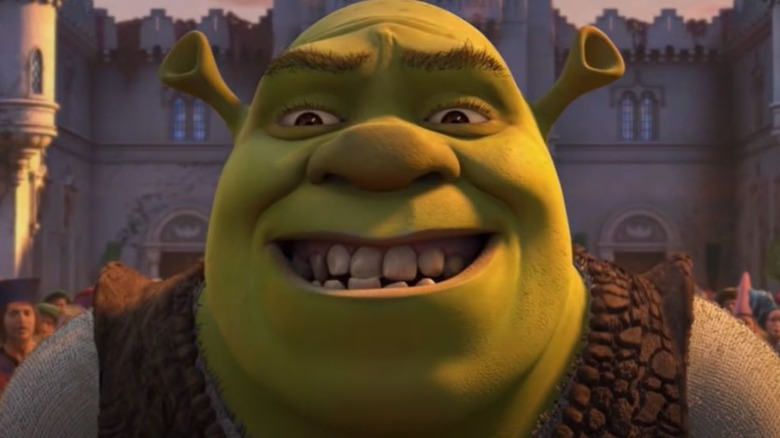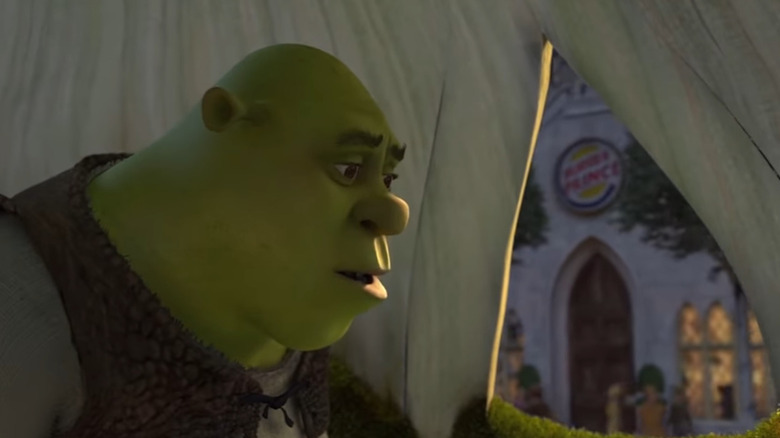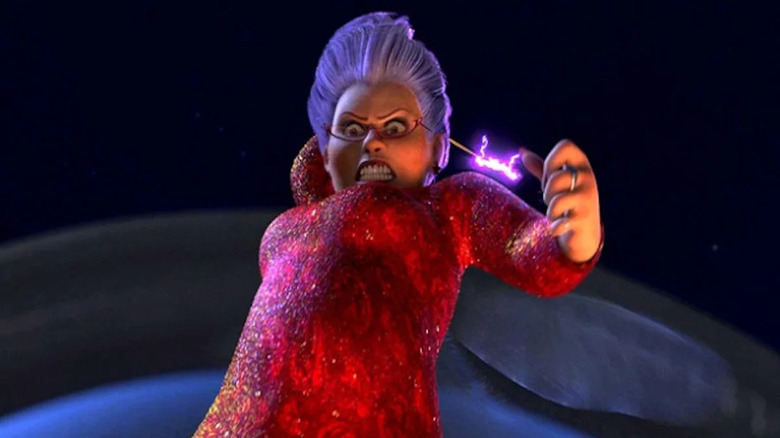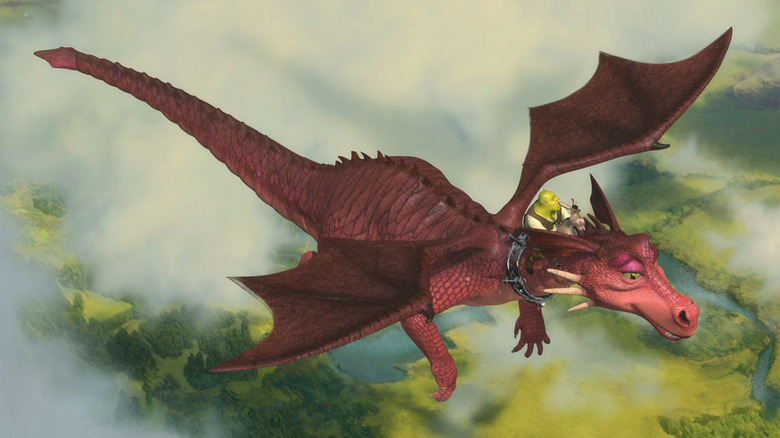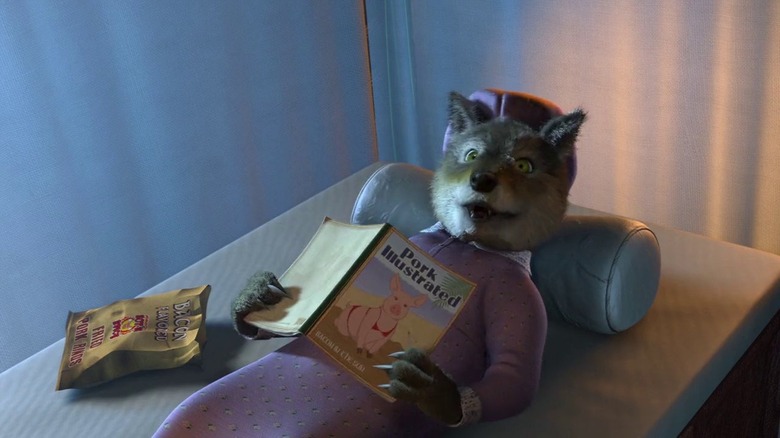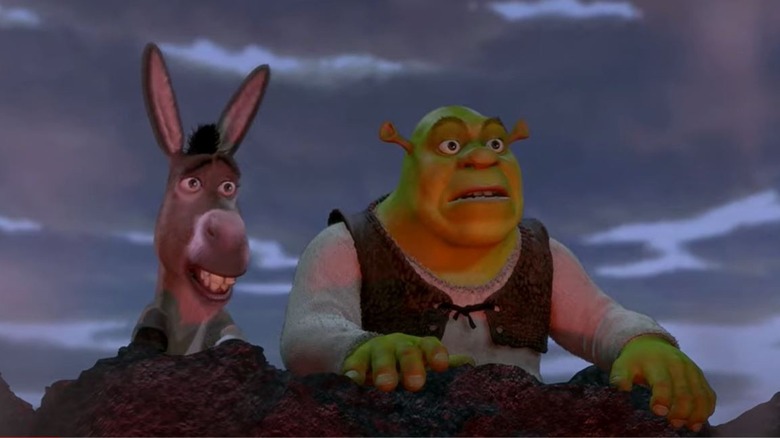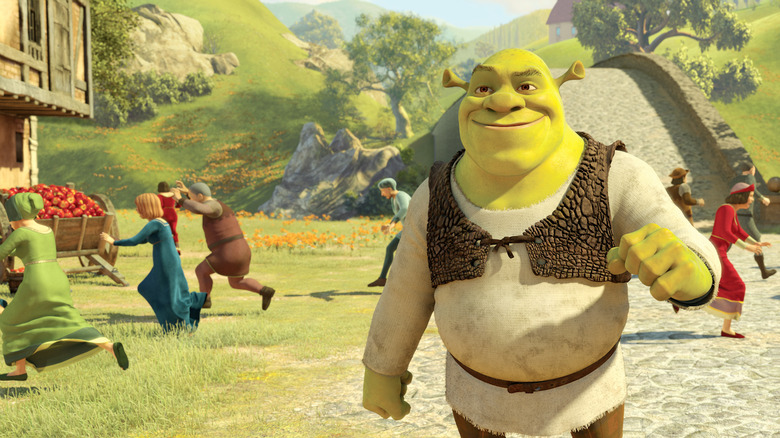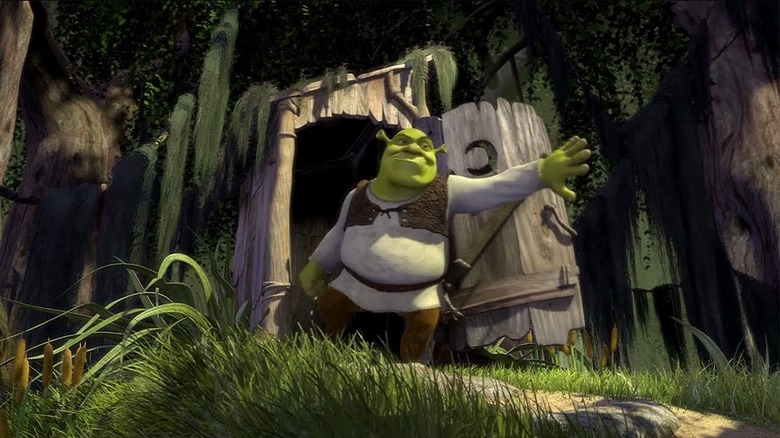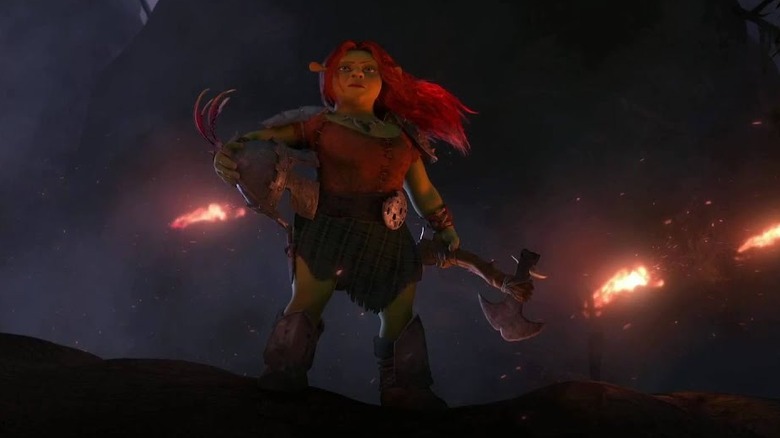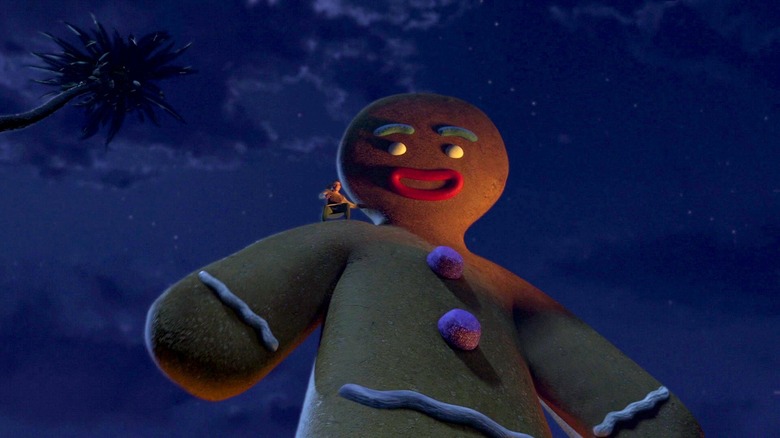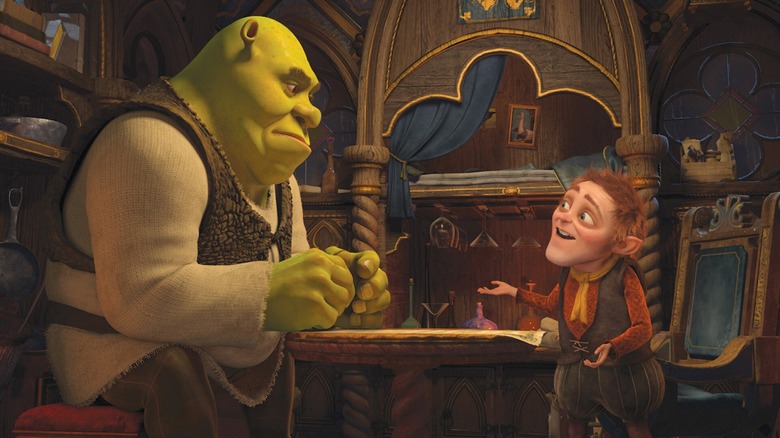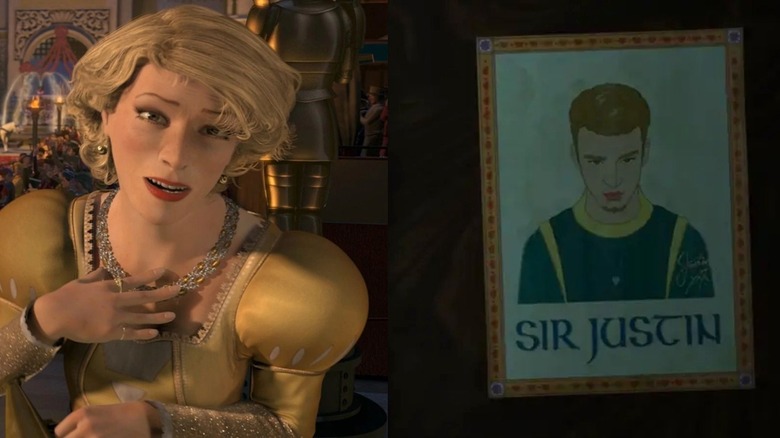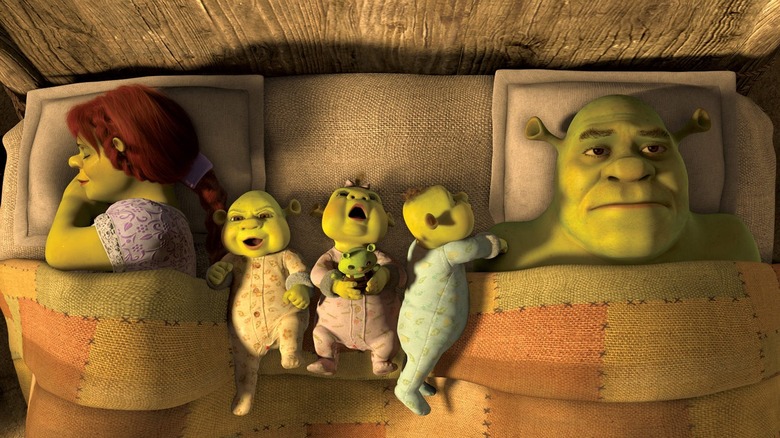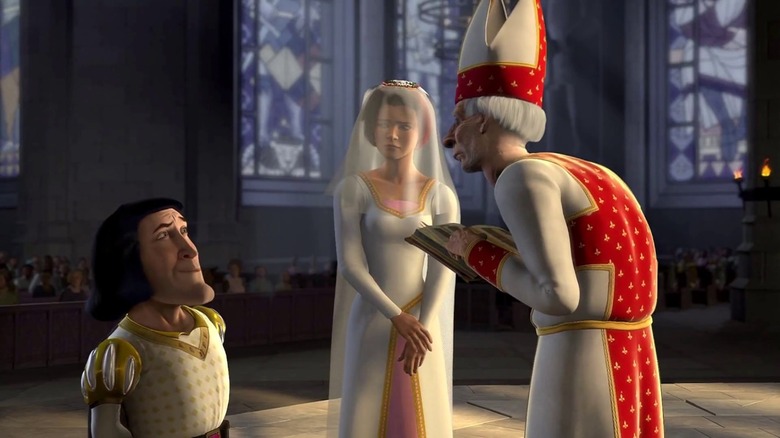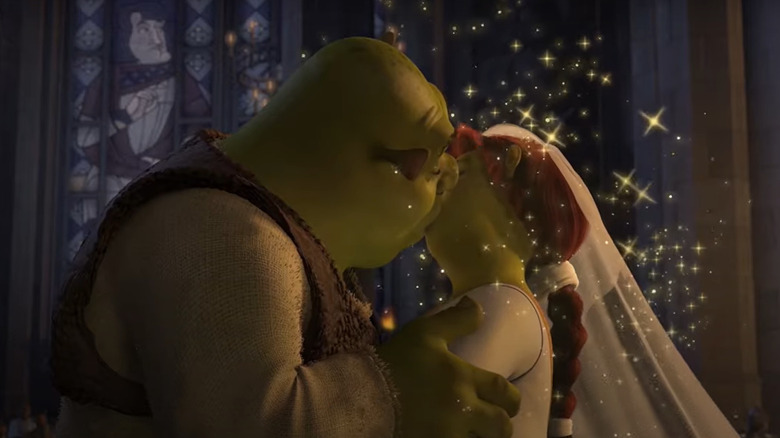These Things Happen In Every Single Shrek Movie
While the "Marvel Cinematic Universe" is sometimes erroneously credited with introducing the concept of a shared-story film series to Hollywood, the idea had already been in play for a long time before that. Case in point, the "Shrek" franchise, which consists of four main movies, a stage play, multiple TV specials, and a spin-off feature.
The main four movies in the series tell the story of an ogre named Shrek, who lives in a swamp and shuns a society that views him as a fearsome monster. A series of adventures bring Shrek out of his self-imposed isolation and surround him with friends and family as they take on a number of adversaries threatening to turn their world upside down. The original "Shrek" released in 2001 was an adaptation of a book by William Steig.
"Shrek" was a breakout success thanks to its talented cast of voice actors and a smartly written screenplay, which poked fun at fairy tale tropes while managing to tell a heartfelt story about appreciating people for their nature rather than their looks. Each subsequent film after "Shrek" in the main series made use of certain narrative devices again and again. Here are some of the things that you can expect to see in all four "Shrek" movies.
Shrek is a reluctant hero
Across his four movies, Shrek has remained a very dynamic character. He can fight, strategize, rally others to his cause, and generally play the part of a charismatic action hero who always ends up saving the day. But the fact remains that being the hero has never been one of Shrek's goals, and in fact it's something he actively fights against.
Every movie about Shrek starts with him refusing the call to action until he is forced to participate. In the original "Shrek," all he wanted was to be left alone in his swamp. But he was forced to take action after Lord Farquaad sent all the fairy tale creatures to his neighborhood. In the sequel, "Shrek 2" (2004), he just wants to enjoy married life with Fiona, but is instead forced to go to the kingdom of Far Far Away and take on the Fairy Godmother.
The trend continues in "Shrek the Third" (2007). This time Shrek is faced with the possibility of becoming king, an idea he detests. And so Shrek hurriedly sets off on a quest to find a replacement who can rule in his stead. Finally, in "Shrek Forever After" (2010), the entire plot gets kickstarted because Shrek makes a wish to get away from all his friends and family and go back to being a solitary ogre once again, if only for a day.
A famous villain
The "Shrek" series is a satire of classic fairy tales about beautiful princesses being rescued by dashing princes, making for a happily ever after. Befitting its satirical nature, the "Shrek" movies put fairy tale creatures front and center of its narrative. This includes making the main villain in each film a famous fairy tale archetype.
It started out in the original "Shrek" with the villain Lord Farquaad. The character is a riff on the stereotypical "Handsome Prince" guy who is supposed to set off on an epic quest to rescue the princess. But in this case, Farquaad is selfish and cowardly, and sends Shrek in his stead to rescue Princess Fiona. In the sequel, the main villain is a manipulative version of the Fairy Godmother who shows up in so many famous fairy tales.
The third movie has another "Handsome Prince" archetype as the main villain, only this Prince Charming is a greater threat than Lord Farquaad, with a relatively more sympathetic backstory. Finally, in "Shrek Forever After," another well-known fairy tale character named Rumpelstiltskin is made the new villain. With all these villains, their actions and motivations are made to reflect the real world rather than adhering to the simplistic good vs. evil narrative of traditional fairy tales.
A villain turns hero
When Shrek is introduced at the beginning of his first movie, the audience is meant to see him as a unheroic. This is built on the traditional view of ogres as the villains of fairy and fantasy stories. The fact that Shrek is secretly a good guy yearning to be loved forms the basis of the movie's entire narrative.
This idea of a scary or villainous looking person secretly being good is also reflected in the character of the fearsome dragon who guards Fiona's tower. She starts out as a villain, but gets married to Donkey by the end of the movie, and shows up in the sequels as one of Shrek's strongest allies. In "Shrek 2," Puss in Boots is initially depicted as an antagonist, who then reveals himself to be an honorable soul and a hero in his own right.
Moving on to "Shrek the Third," the main theme of the story is that traditional fairy tale villains are sick of being seen as inherently evil, and wish to live in a society where they are not constantly judged for their appearance. Finally in the fourth "Shrek" movie, we get to see an entire army of ogres depicted as heroic freedom fighters looking to overthrow the rule of Rumpelstiltskin.
Mocking fantasy tropes
While the "Shrek" series takes place in a fantasy, fairy tale setting, it is less interested in fitting into the world of fantasy and more interested in poking fun at the whole thing. Each movie applies liberal doses of comedy to traditional fairy tale archetypes in a funny and clever manner that can be enjoyed by both kids and adults.
Case in point, the first movie in the series introduces a bunch of fairy tale creatures in new and bizarre ways. There is the Big Bad Wolf who just likes to wear women's clothes and curl up with a book; the Three Little Pigs with strongly German accents for some reason; an overly cocky Robin Hood who gets beaten to a pulp; and a Magic Mirror that talks likes a newscaster.
Later movies in the series continue with this trend. We meet a Fairy Godmother who runs a wish-giving criminal empire; a cat wearing boots who claims to be an ogre-killer; an aged wizard Merlin who is more hippy than sorcerer; a King Arthur who gets bullied at his school; and a Pied Piper who is less a whimsical musician and more of a dreaded bounty hunter. These satirical new takes on classic fantasy characters is something the "Shrek" franchise does better than any other film series.
Shrek and Donkey butt heads
On top of being a heartfelt love story, a biting fantasy satire, and a coming-of-age saga, the original "Shrek" was also an action buddy-cop film about two unlikely partners on the opposite sides of the personality spectrum. Shrek was the gruff, anti-social man-of-action, while his sidekick Donkey was the gregarious people-pleaser with a sunny disposition.
The relationship between Shrek and Donkey covers certain beats again and again in each of the films. At first, Shrek feels impatient with Donkey due to his nosy, chatty nature. Meanwhile, Donkey ignores Shrek's irritation, because he recognizes that beneath the gruff exterior of the formidable ogre there beats a heart of gold. At some point the differences between the two characters prove too much, and they get into a heated argument.
But just when it seems like their friendship is on the verge of breaking up, Shrek and Donkey are reminded of how important they are to each other. The duo make up, and work together to put an end to the problems facing them and their loved ones. From their days of squabbling over who gets to live in the swamp, to raising their children side-by-side, the vitriolic best buds have developed one of the best friendships in the history of cinema.
Shrek scares people
The foundation of the "Shrek" series is built on the unusual idea of having a traditionally villainous ogre in the role of the main hero of a fairy tale. This foundation only works because the the movies master the balancing act between having Shrek act like a typical ogre but also revealing hidden depths of sensitivity and kindness.
And so an important part of each "Shrek" movie is reminding audiences that the main character is a scary ogre by having him terrorize random characters. This was most pronounced in the first "Shrek" movie, where the entire reason Shrek was handed his quest by Lord Farquaad was because Shrek had decimated his entire army single-handedly. The events of "Shrek 2" were also set in motion because Fiona's father could not stomach the idea of a fearsome ogre being his son-in-law.
By the time of the third movie, Shrek had become a beloved figure in the kingdom of Far Far Away, so he was sent to distant lands to scare new characters. In the fourth "Shrek" movie, the mighty ogre had become a bit of a joke to his friends, and so he actually wished for a day to go back to his old ways when he was considered a fearsome monster who could make humans wet themselves with a roar.
Lots of toilet humor
The "Shrek" movies puncture the sense of solemnity that accompanies so many traditional fairy tales with of a plethora of fart and burp jokes. Seriously, the movies really, really go all in on the idea that its cast of characters are some of the most disgusting creatures you will find in all of fairyland.
The first "Shrek" movie introduces its title character by having him burst out of his outhouse with a hearty smile, as though satisfied with a job well done. After Shrek meets Fiona, one of the things they bond over is their mutual love of potty humor, with Fiona joining Shrek in blowing "bubbles" in their mud pit during their honeymoon. Shrek's transformation into his human self is also accompanied by a magical fart that punctures a solemn moment.
In "Shrek the Third," when he learns that he is about to become a father, Shrek has a nightmare in which his newborn child throws up on him in a powerful jet that knocks him off his feet. The fourth movie in the series has Shrek returning to his roots as a fearsome ogre, and that includes rolling around in filth and mud, and generally being his old burpy, farty self.
Fiona kicks some butt
While Shrek is the unlikeliest of heroes for a fairy tale story, Princess Fiona is every bit as unusual in the role of the traditional fairy tale heroine. Other princesses wait around for their princes to come to their rescue, but Fiona prefers to take matters into her own hands with the help of her unexpected martial arts abilities.
Fiona's fighting spirit was first showcased in the original "Shrek." After encountering Robin Hood and his band of Merry Men, Fiona was forced to beat the tar out of them because they insisted on trying to rescue her from Shrek despite her protests. After that came "Shrek 2," in which Fiona knocked out Prince Charming with a headbutt after he tried to give her a true love's kiss.
With the third movie in the series, Fiona's butt-kicking skills suffered a bit of a setback due to her being pregnant at the time, so her equally formidable mother and a bunch of fairy tale princesses helped pick up the slack. Fiona was back in full force in "Shrek Forever After." After a curse dramatically changes the timeline, a new version of Fiona had become a warrior princess and the leader of a tribe of ogres fighting to overthrown the rule of Rumpelstiltskin.
An unlikely band of allies
Each "Shrek" movie features some version of an epic mission that the titular character must fulfill in order to reunite with his loved ones. Despite being a powerful and intelligent ogre, Shrek is frequently overwhelmed by the forces opposing him. And that is why he is forced to rely on the help of a number of unexpected allies.
In the first movie, that unexpected ally turns out to be Donkey. Despite being more of a hindrance than a help at the start of the movie, Donkey moves considerably up the power rankings by the end due to his new girlfriend being a giant, fire-breathing dragon who helps Shrek defeat Farquaad. Then in "Shrek 2," Shrek and Donkey are ably assisted by Puss-in-Boots, Pinocchio, the Gingerbread Man, and his giant ginger-brother.
With "Shrek the Third," the ogre is forced to travel to distant lands to find new allies in Merlin the Magician and King Arthur. By the end of the movie, Shrek and Arthur had also successfully rallied various fairy tale villains to turn on Prince Charming and help them instead. Finally in "Shrek Forever After," despite making everyone forget he existed, Shrek is able to win the day by getting help from an army of ogres, and transformed versions of his old allies.
A magic curse to deal with
In keeping with its fantasy themes, the "Shrek" series relies heavily on magic to get its plot moving along. This is true all the way to the end of each movie, which require Shrek and his allies to overcome some sort of a magic curse in order to win.
In the first movie, that curse was the one Fiona had dealt with since childhood of being transformed into an ogress at night. In the second movie, we're dealing with two curses masquerading as magical gifts. One transforms Shrek into a human for a limited period of time unless he can get Fiona to kiss him, and another which would brainwash Fiona into falling in love with Fairy Godmother's son. "Shrek the Third" makes the curse a bit of a metaphor for impending fatherhood. Shrek thinks he is not ready to handle being a dad and is terrified of what the birth of his child will do to his life. Then "Shrek Forever After" makes the curse a real-life thing again when Rumpelstiltskin tricks Shrek and turns his wish into a curse.
With all these scenarios, the curses offer a "ticking time bomb" scenario to the narrative that adds a sense of urgency and danger to the character's actions. And all of them end with some sort of emotional growth for Shrek and his friends, from Fiona learning to love her ogress self to Shrek learning to love being a father.
Pop culture references
One major reason the "Shrek" series feels so modern despite being set in medieval times is because of the many pop culture references sprinkled throughout the movies. In the very first movie, we get the Magic Mirror acting like a game show host, and references to Disneyland when Shrek visits Lord Farquaad's kingdom for the first time.
The references get even more blatant in the second movie, which ends with an "American Idol" pastiche called "Far Far Away Idol." Not to mention the Fairy Godmother running her entire wish business empire like a real-world corporation complete with disgruntled employees who don't get dental plans. In "Shrek the Third," King Arthur's world of Worcestershire is turned into a typical modern high-school movie setting where Lancelot and his crew are the jocks.
The fourth movie in the series makes a typical Chuck E. Cheese-style birthday party the scene which kickstarts the main events of the story. All these modern references allow the franchise to poke fun at traditional fantasy archetypes by viewing them through a post-modern lens –one that questions the behavior of such archetypes in a more realistic world setting, where a Fairy Godmother can be a scheming villain or an ogre can act like an unlikely hero.
Shrek needs to count his blessings
Despite being a heroic, generous, and considerate guy, all those qualities are buried pretty deep down in Shrek's personality. The traits that are on the surface are a lot less likeable, like grumpiness, sarcasm, cynicism — and a desire, born from a lonely and difficult childhood, to avoid being around other people for too long.
All this means that Shrek starts out each movie being dissatisfied with his lot in life. In the first movie, he hates the fact that he has to leave the solitude of his swamp to go on a quest to rescue Fiona with Donkey. Then he hates the fact that he has to visit Fiona's parents in "Shrek 2." The third movie has Shrek dreading the prospect of becoming a father. And the fourth movie has him yearning to leave his hectic family life behind and go back to his old ways of being a solo ogre in his swamp.
By the end of each movie, Shrek is forced to realize that the things he has had to accept so reluctantly are actually the things that give his life meaning, like the relationships of love and abiding friendship he develops with Fiona and Donkey; and coming to see Fiona's parents and their kingdom as his own; and growing to love his new role as a father and a family man. By the end of each movie, Shrek is filled with a newfound sense of appreciation for the blessings bestowed on his life by friends and family.
Stopping a major ceremony
Each "Shrek" movie deals with a curse that must be undone. In most fantasy stories, such curses are removed via lots of gory action and the slaying of monstrous creatures. But with the "Shrek" franchise being much more family-friendly, ending the curse instead involves Shrek putting an end to some major ceremony at the last moment that includes a definite time limit to raise the stakes of the story.
In the original "Shrek" movie, that ceremony was the wedding between Lord Farquaad and Prince Fiona, which Shrek needed to stop so he could be with Fiona instead. "Shrek 2" had a giant party at the end thrown by Fairy Godmother, during which Prince Charming was supposed to dance with Fiona and give her a kiss to make her fall in love with him. Fortunately, despite Shrek being too late to stop the kiss this time, true love prevailed in the end.
Then in the third movie, Prince Charming plotted to pull off an elaborate stage play at the end during which he would kill Shrek and crown himself the new king of Far Far Away. This time it was Fiona who jumped in to interrupt the ceremony and rescued her husband in the nick of time. Finally in "Shrek Forever After," the main plot involves a false reality that must be undone before sunrise in order to get things back to the way they used to be.
It all ends with a kiss
Amidst all the fart jokes, pop culture references, zany characters, and over-the-top villains, the "Shrek" series at their core tell the tale of a heartfelt love story between the titular character and the love of his life Fiona. It was a love that blossomed in the first movie through unlikely events, and grew stronger with each new film in the series.
That does not mean the course of true love was ever easy. All through the series, Shrek was tortured by his inner demons. The fear of being rejected by society and the woman he loves drives Shrek to act nasty towards Fiona on way too many occasions. Shrek also has to repeatedly learn that being in a committed relationship means giving up his old bachelor ways and making room in his life for a wife and children.
For her part, Fiona never gives up on Shrek, who was the only one to see her ogress form and still feel love for her. The love between Shrek and Fiona remains strong despite whatever challenges the movies throw at them. And each movie ends with a passionate kiss shared between the two, one that puts to rest their troubles and concludes the story with a happy ending.
